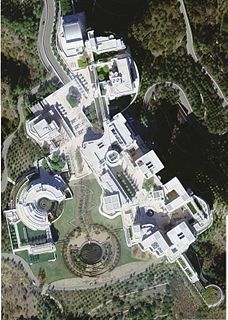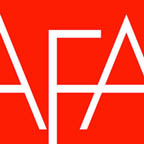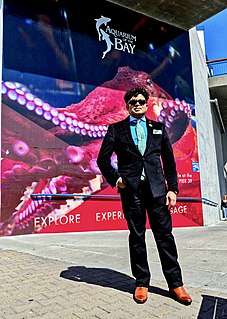
The Los Angeles County Museum of Art (LACMA) is an art museum located on Wilshire Boulevard in the Miracle Mile vicinity of Los Angeles. LACMA is on Museum Row, adjacent to the La Brea Tar Pits.
Keck Graduate Institute (KGI) is a private graduate school in Claremont, California. Founded by Henry Riggs in 1997, it is the seventh and newest member of the Claremont Colleges.

The Claremont Graduate University (CGU) is a private, all-graduate research university in Claremont, California. Founded in 1925, CGU is a member of the Claremont Colleges which includes five undergraduate and two graduate institutions of higher education.

The J. Paul Getty Trust is the world's wealthiest art institution, with an estimated endowment of US$7.7 billion in 2020. Based in Los Angeles, California, it operates the J. Paul Getty Museum, which has two locations – the Getty Center in the Brentwood neighborhood of Los Angeles and the Getty Villa in the Pacific Palisades neighborhood of Los Angeles. Its other programs are the Getty Foundation, the Getty Research Institute, and the Getty Conservation Institute.

The Claremont Institute is a conservative think tank based in Upland, California. The institute was founded in 1979 by four students of Harry V. Jaffa. The Institute publishes the Claremont Review of Books, as well as other books and publications.
Judy Fiskin is an American artist working in photography and video, and a member of the art school faculty at California Institute of the Arts. Her videos have been screened in the Documentary Fortnight series at the Museum of Modern Art in New York, at the Los Angeles County Museum of Art, the Hammer Museum in Los Angeles, and at the J. Paul Getty Museum in Los Angeles; her photographs have been shown at MOCA, the Museum of Contemporary Art in Los Angeles, at the Getty Museum in Los Angeles, at The New Museum in New York City, and at the Pompidou Center in Paris.

The Getty Research Institute (GRI), located at the Getty Center in Los Angeles, California, is "dedicated to furthering knowledge and advancing understanding of the visual arts".
The Getty Foundation, based in Los Angeles, California at the Getty Center, awards grants for "the understanding and preservation of the visual arts". In the past, it funded the Getty Leadership Institute for "current and future museum leaders", which is now at Claremont Graduate University. Its budget for 2006–07 was $27.8 million. It is part of the J. Paul Getty Trust.

The Peter F. Drucker and Masatoshi Ito Graduate School of Management, or more commonly, the Drucker School of Management, is the business school of Claremont Graduate University, which is a member of the Claremont Colleges. The school is named in honor of Peter Drucker, who taught management at the school for over 30 years.
The Bay Area Video Coalition (BAVC) is a nonprofit organization that works to connect independent producers and underrepresented communities to emerging media technologies. It was founded in 1976 in San Francisco.

The American Federation of Arts (AFA) is a nonprofit organization that creates art exhibitions for presentation in museums around the world, publishes exhibition catalogues, and develops education programs. The organization’s founding in 1909 was endorsed by Theodore Roosevelt and spearheaded by Secretary of State Elihu Root and eminent art patrons and artists of the day. The AFA’s mission is to enrich the public’s experience and understanding of the visual arts, and this is accomplished through its exhibitions, catalogues, and public programs. To date, the AFA has organized or circulated approximately 3,000 exhibitions that have been viewed by more than 10 million people in museums in every state, as well as in Canada, Latin America, Europe, Asia, and Africa.
The United Neighborhood Organization (UNO) is a non-profit organization in Chicago, Illinois. UNO's mission is to lead the transformation of the Hispanic community toward an educated, powerful and prosperous citizenry by engaging and challenging it to redefine its potential and its legacy in metropolitan Chicago and The United States of America.

Suzanne Muchnic is an art writer who was a staff art reporter and art critic at the Los Angeles Times for 31 years. She has also written books on artists, collectors, and museums.
Pacific Standard Time: Art in L.A., 1945–1980 was a scholarly initiative funded by the J. Paul Getty Trust to historicize the contributions to contemporary art history of artists, curators, critics, and others based in Los Angeles. Planned for nearly a decade, PST, as it was called, granted nearly 60 organizations throughout Southern California a total of $10 million to produce exhibitions that explored the years between 1945 and 1980. Underscoring the significance of this project, art critic Roberta Smith wrote in The New York Times:
Before [PST], we knew a lot [about the history of contemporary art], and that lot tended to greatly favor New York. A few Los Angeles artists were highly visible and unanimously revered, namely Ed Ruscha and other denizens of the Ferus Gallery, that supercool locus of the Los Angeles art scene in the 1960s, plus Bruce Nauman and Chris Burden, but that was about it. After, we know a whole lot more, and the balance is much more even. One of the many messages delivered by this profusion of what will eventually be nearly 70 museum exhibitions is that New York did not act alone in the postwar era. And neither did those fabulous Ferus boys.
Zoltan Pali is an architect from Los Angeles, California.
Bettina Korek is an American arts advocate, writer, and the founder of ForYourArt, a public practice organization based in Los Angeles. She founded ForYourArt a platform to produce and distribute artists’ work. Korek is also a member of the Los Angeles County Arts Commission

George Jacob is the president & chief executive officer of Bay Ecotarium/Bay.Org in San Francisco, where he oversees a staff of 200 at its six institutions including the Aquarium of the Bay, The Bay Institute, the Sea Lion Center, the Eco Center at Heron's Head Park, the Bay Model Alliance and the Bay Academy.

Deborah Marrow was a foundation director and art historian who spent a 36-year career with the J. Paul Getty Trust in Los Angeles, California. She worked at the Trust from 1983 to 2019 including two assignments as interim president and chief executive officer and 30 years as Director of the Getty Foundation.
The Los Angeles Center for Photographic Studies (LACPS) was an artist-run nonprofit arts organization that presented photography exhibitions, lectures, and workshops in and around Los Angeles, California between 1974 and 2001.








